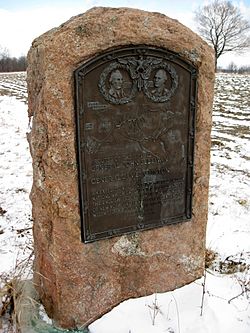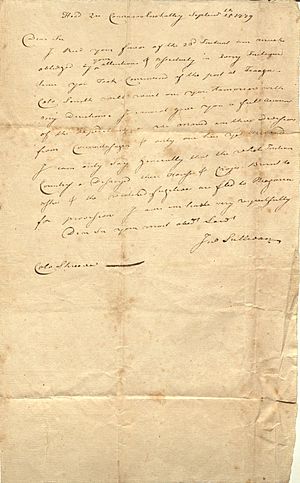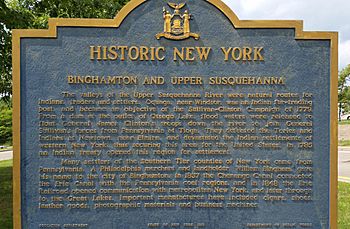Sullivan Expedition facts for kids
Quick facts for kids Sullivan Expedition |
|||||||
|---|---|---|---|---|---|---|---|
| Part of American Revolutionary War | |||||||
 Commemorative plaque of the Sullivan Expedition in Lodi, New York |
|||||||
|
|||||||
| Belligerents | |||||||
| Iroquois Confederacy |
|||||||
| Commanders and leaders | |||||||
| Sayenqueraghta Cornplanter Joseph Brant Little Beard John Butler |
John Sullivan James Clinton |
||||||
| Strength | |||||||
| 1,000 Iroquois 200–250 militia (known as Butler's Rangers) |
4,000 | ||||||
| Casualties and losses | |||||||
| Unknown | 33 killed, 41 wounded | ||||||
| Total Iroquois casualties: 5,000 refugees, 4,500 deaths from starvation, exposure, disease, and violence (per Koehler) |
|||||||
The Sullivan Expedition was a major military campaign during the American Revolutionary War in 1779. It was also called the Sullivan-Clinton Expedition. This campaign was fought by the United States against Loyalists (Americans who supported the British) and four nations of the Iroquois Confederacy. These Iroquois nations had allied with the British.
General George Washington ordered the expedition. He wanted to respond to earlier attacks by the Iroquois and British on American settlements. These attacks happened in 1778 at places like Wyoming, German Flatts, and Cherry Valley. Washington's goal was to "take the war home to the enemy" and lower their spirits.
The Continental Army used a strategy called "scorched-earth". This means they destroyed everything in their path. They focused on the lands of the Iroquois Confederacy (also known as the Longhouse Confederacy). This area is now in Pennsylvania and western New York.
The expedition was mostly successful. More than 40 Iroquois villages were destroyed. Their winter crops were also ruined. This greatly weakened the Iroquois' power in New York. About 5,000 Iroquois people had to flee to Fort Niagara to seek British protection.
After the campaign, the Iroquois' military strength was broken. This opened up large areas like the Ohio Country and the Great Lakes for new settlements after the war. Some historians describe the expedition as an attempt to remove the Iroquois from their lands. Today, many markers in Upstate New York show where Sullivan's troops marched and where Iroquois villages once stood.
Contents
What Was the Expedition?
The Sullivan Expedition happened in the summer of 1779. It was led by Major General John Sullivan and Brigadier General James Clinton. The army started marching from Easton, Pennsylvania, on June 18. They returned to George Washington's main camp in New Jersey by October 3.
There was only one major battle during the campaign, the Battle of Newtown. This battle took place along the Chemung River in western New York. The Iroquois tribes often moved away before the large American army arrived.
The expedition caused great harm to the Iroquois nations' economies. Their crops, villages, and belongings were burned. This destroyed their way of life. Without shelter and food, the power of the Iroquois Confederacy was broken. Many Iroquois people died from lack of food and shelter. This number was much higher than those killed in the Battle of Newtown. In that battle, about 1,000 Iroquois and Loyalists fought against 3,200 American soldiers.
The American forces systematically destroyed at least forty Iroquois villages. These villages were in the Finger Lakes region of western New York. The Iroquois who survived fled to British areas in Canada. Many refugees faced extreme hardship during the winter of 1779. They starved or froze, even with British help.
The Sullivan Expedition devastated the Iroquois' towns and crops. It made them rely on the British for survival. The Iroquois' spirits never fully recovered. After this, they mostly limited their attacks to small hunting parties. Many Iroquois people moved permanently north into Canada.
Why the Expedition Happened
When the American Revolutionary War began, both the British and the American Continental Congress wanted the Iroquois Confederacy to be on their side or stay neutral. The Six Nations of the Iroquois had different ideas. Most Mohawks, Cayugas, Onondagas, and Senecas chose to support the British. But the Oneidas and Tuscaroras sided with the American revolutionaries. So, for the Iroquois, the American Revolution became like a civil war.
The Iroquois homeland was on the border between Quebec, New York, and Pennsylvania. After a British army surrendered at the Battles of Saratoga in 1777, Loyalists and their Iroquois allies attacked American settlements. They also attacked villages of Iroquois who supported the Americans. These attacks were led by people like Loyalist commander Colonel John Butler, Sayenqueraghta, Mohawk leader Joseph Brant, and Seneca chief Cornplanter. They operated from Fort Niagara.
In July 1778, Colonel Butler led his Butler's Rangers and Iroquois forces in an attack on Pennsylvania's Wyoming Valley. They defeated 360 American defenders. In September 1778, American Colonel Thomas Hartley responded by burning several Iroquois villages. At the same time, Butler's Rangers attacked German Flatts, destroying homes and fields. Other American units also burned Iroquois villages.
On November 11, 1778, Loyalist Captain Walter Butler (John Butler's son) led an attack on Cherry Valley. Iroquois warriors joined him. They attacked civilians, killing many and taking captives. The town was looted and destroyed. These attacks by Loyalists and Iroquois had ruined much of New York and Pennsylvania. Thousands of farmers fled, which meant less food for the Continental Army.
The Cherry Valley attack convinced the Americans that they needed to act. In April 1779, American Colonel Goose Van Schaick led an expedition against the Onondaga, destroying several villages. When the British focused their efforts on the southern colonies in 1779, Washington decided to launch a larger attack towards Fort Niagara. He chose Major General John Sullivan to lead it.
Washington's orders to Sullivan were very clear:
Orders of George Washington to General John Sullivan, at Head-Quarters (Wallace House, New Jersey) May 31, 1779
The Expedition you are appointed to command is to be directed against the hostile tribes of the Six Nations of Indians, with their associates and adherents. The immediate objects are the total destruction and devastation of their settlements, and the capture of as many prisoners of every age and sex as possible. It will be essential to ruin their crops now in the ground and prevent their planting more.
I would recommend, that some post in the center of the Indian Country, should be occupied with all expedition, with a sufficient quantity of provisions whence parties should be detached to lay waste all the settlements around, with instructions to do it in the most effectual manner, that the country may not be merely overrun, but destroyed.
But you will not by any means listen to any overture of peace before the total ruinment of their settlements is effected. Our future security will be in their inability to injure us and in the terror with which the severity of the chastisement they receive will inspire them.
The Expedition's Journey
General Sullivan's main army started from Easton, Pennsylvania, on June 18. They marched to the Susquehanna River and followed it upstream to Tioga, now Athens, Pennsylvania. General James Clinton gathered another group of soldiers at Schenectady, New York. He moved west along the Mohawk River Valley to Canajoharie. Then he went overland to Otsego Lake. Clinton's group was to march down the Susquehanna to meet Sullivan at Tioga. They were ordered to destroy all Iroquois villages along their way. Sullivan's army was supposed to have 5,000 men, but it ended up being closer to 4,000.
The main army arrived at Tioga on August 11. They built a temporary fort called Fort Sullivan. It was at the meeting point of the Chemung and Susquehanna Rivers.
Sullivan sent a scouting party to Chemung. They found the village active. Sullivan then marched his army all night and attacked at dawn. But the town was empty. His soldiers burned the town and destroyed all its crops.
Clinton's group set up camp at Otsego Lake on June 30. He waited for orders until August 6. The next day, he began his march of about 154 miles to Tioga. He brought all his supplies in 250 small boats. Sullivan sent soldiers to meet Clinton and escort him. The entire army came together on August 22.
On August 26, the combined army of about 3,200 men left Fort Sullivan. They marched north into the Six Nations territory in central western New York.
The Battle of Newtown
The campaign had only one major battle, the Battle of Newtown, fought on August 29. It was a complete victory for the Continental Army. Later, a small group of American soldiers was ambushed, and most were captured or killed.
Sullivan's forces reached their farthest point at the Seneca town of Chenussio (also called Little Beard's town) on September 15. They completely destroyed the Iroquois villages there. Then they returned to Fort Sullivan at the end of the month. Three days later, the army left the fort to go to Morristown, New Jersey, for winter. Sullivan reported that forty Iroquois villages were destroyed. This included Catherine's Town, Goiogouen, Chonodote, and Kanadaseaga. All the Iroquois crops and fruit trees were also destroyed.
Before the expedition, the Seneca war chief Sayenqueraghta warned his people. He said the Americans wanted to remove the Iroquois from their lands. Mohawk leader Joseph Brant also warned that the Americans wanted to destroy the Iroquois.
The British governor of Quebec, Frederick Haldimand, did not send enough troops to help his Iroquois allies. By the time he sent a force of Loyalists and Iroquois, the American expedition had already finished.
Brodhead's Expedition
At the same time, Colonel Daniel Brodhead led another expedition. He left Fort Pitt on August 14, 1779, with 600 men. He marched up the Allegheny River into Seneca and Lenape lands. Most Iroquois warriors were away fighting Sullivan's army. So, Brodhead met little resistance. He destroyed about 10 villages, including Conewango. Brodhead turned back after destroying villages near Salamanca, New York. He never met up with Sullivan's main force.
Horseheads

On their way back, Sullivan's horses were very tired from carrying heavy equipment. Just north of Elmira, New York, Sullivan had to put down his pack horses. Years later, the skulls of these horses were placed along the trail as a warning to settlers. This area became known as "the Valley of Horses Heads." Today, it is the village and town of Horseheads, New York.
Aftermath
Sullivan, who had been ill, resigned from his position in 1780. His health continued to get worse.
More than 5,000 Iroquois refugees fled to the area around the British-held Fort Niagara. They sought supplies and protection from the British. Many Tuscarora and Oneida people also joined the British side. The British gave the Iroquois 675,000 acres of land in Canada. About 1450 Iroquois and 400 allies lived at a new reserve at Grand River.
Despite the widespread destruction, Washington was disappointed. He wanted a decisive battle and to capture Fort Niagara. However, capturing Fort Niagara was very difficult for Sullivan's army.
Iroquois warriors and Loyalists continued to raid the Mohawk and Schoharie Valleys in 1780 and 1781. They caused much damage and killed many settlers. The last major raid happened in October 1781. It was defeated at the Battle of Johnstown.
Results of the Expedition
The campaign destroyed the Iroquois' towns and way of life. In the long run, it broke the Iroquois Confederacy's ability to live as they had before. The expedition caused the Iroquois people to spread out. It also led to a famine among them. They could not support themselves during the harsh winter of 1779–1780. Some historians believe that many Iroquois people died from starvation and exposure because of the expedition.
After the Revolutionary War, much of the Iroquois land was taken by the United States government. This happened in the Treaty of Fort Stanwix (1784). Many Iroquois people moved to Canada, Oklahoma, and Wisconsin. After the Treaty of Paris (1783) ended the war, European-Americans began settling in these newly empty areas. The remaining Iroquois were isolated in villages under new land treaties.
American settlers continued to move onto Native American lands in the Old Northwest. This led the Iroquois and other tribes to form the Northwestern Confederacy. They wanted to resist American expansion. This led to more military campaigns against them by the United States in the Northwest Indian War.



